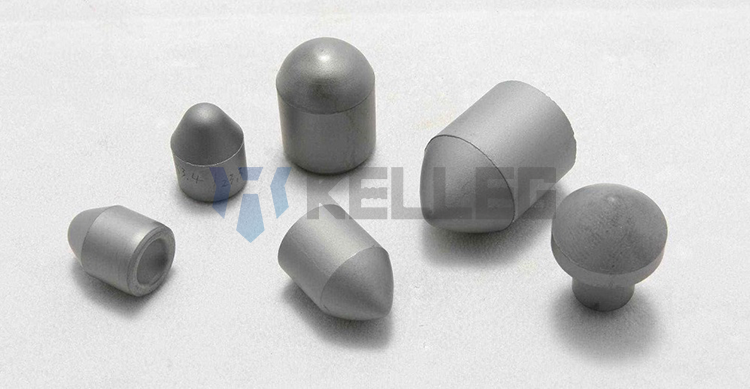2020 官网升级中!现在您访问官网的浏览器设备分辨率宽度低于1280px请使用高分辨率宽度访问。
With the continuous upgrading of rock drilling equipment and people’s pursuit of rock drilling efficiency, cemented carbide as a bit tooth needs to have good performance. After all, due to the harsh operating environment of the drill bit, the cemented carbide bears a lot of impacts, shear load, and complex alternating stress during operation. So what is cemented carbide, and what does it do? Today we will share it with you.

Cemented carbide is a kind of alloy material made by powder metallurgy process, which is composed of a hard compound of refractory metal (mainly tungsten carbide) and bonding metal (main cobalt). It is used in military, aerospace, machining, metallurgy, oil drilling, mining tools, electronic communications, construction, and other fields.
1. High hardness, wear resistance, and red hardness
The hardness of cemented carbide at room temperature can reach 86~93HRA, equivalent to 69~81HRC. It can maintain high hardness at 900~1000℃ and has excellent wear resistance. Compared with high-speed tool steel, the cutting speed can be 4~7 times higher, the service life is 5~80 times longer, and it can cut hard materials with hardness up to 50HRC.
2. High strength and elastic modulus
The compressive strength of cemented carbide is as high as 6000MPa, and the elastic modulus is (4~7) × 105MPa, which is higher than those of high-speed steel. But its flexural strength is low, generally 1000~3000MPa.
3. Good corrosion resistance and oxidation resistance
Generally, it has good resistance to atmospheric, acid, alkali, and other corrosion, not easy oxidation.
4. Small coefficient of linear expansion
When working, the shape and size are stable.
5. The formed products are no longer processed and reground
Due to the high hardness and brittleness of cemented carbide, cutting or regrinding will not require after powder metallurgy forming and sintering. When reprocessing is needed, only electrical machining such as EDM, wire cutting, electrolytic grinding, or special grinding wheel grinding can be used. Products of certain specifications are usually made of cemented carbide, using brazing, bonding, or mechanical clamping on the cutter body or mold body use.
Let’s take a look at the key performance indicators of cemented carbide.
Common performance indicators of cemented carbide include density, hardness, coercive force, magnetic saturation, bending strength, fracture toughness, wear resistance, porosity, etc. Among them, density, coercive force, magnetic saturation, and grain distribution are judged by some first-class cemented carbide manufacturers as key indicators for the quality of cemented carbide. The specific reasons are as follows.
1. Density: It reflects the most significant index of composition and porosity of cemented carbide.
2. Coercive force: The coercive force of cemented carbide is mainly related to the cobalt content and its dispersion degree.
3. Magnetic saturation: Magnetic saturation reflects the C content in the alloy, and the accuracy of the alloy carbon content measured by magnetic saturation reaches 0.01%.
4. Fracture toughness: It is one of the most important mechanical performance indicators used to measure the service life of cemented carbide under actual working conditions. Generally, inversely proportional to hardness. Commonly used test methods are the indentation method and prefabricated crack fracture-strength method.
5. Grain distribution: According to the different WC grain distributions, the alloy includes uniform and non-uniform structure alloy. The uniform structure alloy WC grain has a normal distribution, and the WC grain distribution of non-uniform structure alloy has double peaks.
The characteristics and key performance indicators of cemented carbide make it widely used. Let’s look at its use in detail.
1. Cutting tools: Cemented carbide can be used as a variety of cutting tools, the amount of cemented carbide cutting tools in our country accounts for about a third of the total cemented carbide production, including about 78% for welding tools and about 22% for indexable tools. CNC tools with cemented carbide only accounted for about 20% of the indexable tools with cemented carbide, in addition to solid carbide drills, solid carbide small circular saw blades, carbide micro drilling, and other cutting tools.
2. Geological mining tools: It is also a major use of cemented carbide.
In the geological use of cemented carbide is about 25% of the total value of cemented carbide, mainly used for rock impact drilling bit, drilling bit for mining oil field, drilling hole, coal cutting, and road cutting, and impact drilling in the building materials industry, etc.
3. Models: Cemented carbides used for all kinds of mold account for about 8% of the total production of cemented carbides. Among them, the cemented carbide rolls for rolling wire rods account for about 3% of the total cemented carbide production.
4. Structural and wear-resistant parts: Carbide can be used to make structural parts, such as rotary seal rings, compressor pistons, lathe chucks, grinder mandrels, etc. It can also be made into wear parts such as nozzles, rails, plungers, tire cleats, snow plow boards, etc.
5. Cavity for high pressure and high-temperature resistance: the most important use is to produce top hammers, cylinders, and other products for synthetic diamond.
6. Other uses: In recent years, it has been expanding in the civilian field, such as watch chain cases, zipper heads of advanced luggage, carbide trademark, etc.
The excellent properties of cemented carbide make it widely used. With the continuous development of the economy, the demand for cemented carbide is also high-speed growth. At the same time, people will put forward higher requirements for alloy performance, which also requires cemented carbide manufacturers to closely follow the development of the market and develop products with stable quality and better effects while strictly controlling the production process.